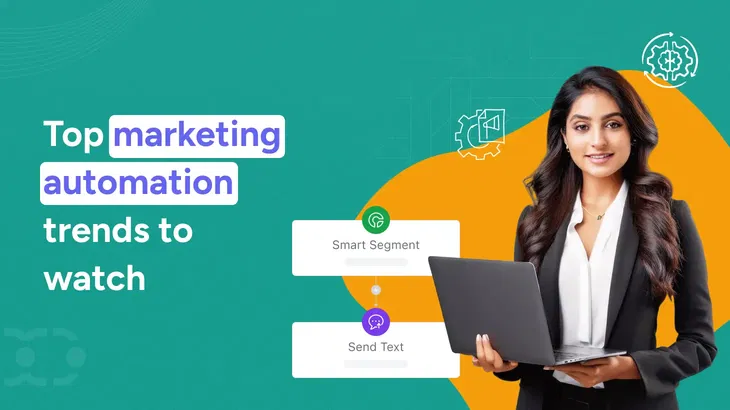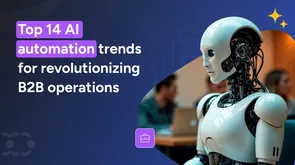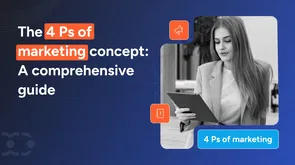1. AI-powered Personalization
AI-powered personalization is reshaping how businesses engage with their customers.
By leveraging machine learning and AI-powered predictive analytics, businesses can get a deep understanding of customer preferences and deliver more tailored content.
This personalization enables businesses to reach customers with the right message at the right time, improving engagement and driving conversion rates.
AI integrates seamlessly into marketing automation systems, allowing businesses to deliver tailored experiences at scale. As companies focus on improving customer engagement, AI ensures every interaction is relevant, timely, and impactful.
2. Conversational marketing
Conversational marketing is increasingly important as businesses seek more direct, real-time ways to interact with customers.
With the rise of chatbots, live chat, and messaging apps, marketing automation platforms enable real-time personalized conversations that nurture leads and guide them through the marketing funnel stages.
AI-driven conversational tools enable businesses to provide instant responses to customer inquiries, personalized recommendations, and even resolve issues on the spot.
Tools like WADesk – an AI-powered WhatsApp marketing tool help teams manage multiple WhatsApp accounts, automate replies, and scale conversations across channels.
These tools allow companies to engage with customers across multiple marketing channels, whether through websites, social media, or mobile apps, ensuring that conversations are timely and relevant.
These innovations are part of the automation trends that focus on AI marketing automation trends, enhancing lead conversion with timely and personalized responses.
3. Omnichannel marketing integration
Omnichannel marketing is key to delivering a seamless experience across multiple channels, ensuring consistent communication and brand presence. Omnichannel CRM is used to manage marketing campaigns and can significantly enhance your strategy.
By centralizing data across various channels, companies can create targeted campaigns that deliver the right message at the right time, improving customer engagement and loyalty.
Through omnichannel marketing integration, businesses can maintain a cohesive brand voice while optimizing customer experiences across multiple marketing channels.
This will be a key driver in the marketing automation trends 2025, as companies seek to maximize their marketing automation market size by meeting customers where they are.
4. Predictive analytics for lead scoring
Predictive analytics is transforming how businesses approach lead scoring. Using AI and machine learning algorithms, predictive analytics can help companies identify which leads are most likely to convert, helping drive immediate sales by prioritizing high-value prospects.
Research by Gartner shows that 63% of organizations that implemented predictive analytics for lead scoring saw a 20-30% improvement in conversion rates.
Predictive models can evaluate factors like customer preferences, purchase behavior, and past engagement to determine the likelihood of conversion.
Marketing automation platforms with predictive lead-scoring capabilities allow businesses to prioritize high-value leads, ensuring that sales efforts are focused on the most promising prospects.
These predictive AI models are a core part of the marketing automation objectives that drive smarter decision-making and enhanced lead conversion.
5. Behavioral triggering
Behavioral triggering is becoming a key tool in marketing automation, helping businesses analyze user behavior and purchase history to trigger the right message at the right moment.
Businesses can trigger automated actions based on these behaviors by tracking customer behaviors, such as website visits, social media interactions, or cart abandonment.
For example, if a customer abandons their cart or revisits a product multiple times, an automated follow-up email or discount offer can be triggered, encouraging them to complete the purchase. This automated, timely response boosts customer engagement and significantly increases conversion rates.
Integrating behavioral triggering into your marketing automation strategy ensures that every message is relevant, enhancing the overall customer experience and moving leads further down the sales funnel.
6. Social media automation
Social media is a crucial channel for customer engagement, and social media automation enables businesses to manage their efforts more effectively.
Automating tasks like post-scheduling, monitoring mentions, and analyzing performance enables enterprises to maintain an active social presence while reducing manual effort.
By using social media automation, businesses can schedule social media posts at optimal times, ensuring content reaches the right audience when they are most likely to engage.
These marketing automation software also support automated social media marketing, tracking interactions, and generating insights to improve campaign timing and engagement.
Social media automation helps businesses stay consistent in their marketing efforts while saving valuable time and resources.
7. Email drip campaigns
Email drip campaigns are a powerful way to nurture leads and maintain customer engagement over time.
By automating a series of personalized emails, businesses can send targeted messages based on customer behavior, preferences, or stage in the sales cycle.
Email drip campaigns designed to educate, inform, and convert leads at the right moments are essential for building lasting customer relationships.
Marketing automation tools enable businesses to segment their audience and send targeted emails that feel timely and personal, resulting in higher engagement and retention rates.
By automating these campaigns, businesses can save time and ensure consistent communication, ultimately driving improved conversion rates and customer loyalty.
8. AI-powered content creation
AI is revolutionizing the content creation, enabling businesses to produce high-quality, relevant content more efficiently.
AI-powered content creation tools utilize natural language processing and machine learning to generate a wide range of content types, including blog posts, product descriptions, and social media updates.
Integrating AI tools into marketing automation platforms helps businesses create content that aligns with customer preferences and behaviors.
By automating content creation, companies can save time and ensure their messages remain relevant, ultimately driving higher customer engagement and improved campaign performance.
AI tools also provide valuable insights, helping businesses predict what types of marketing content will resonate with their audience, which leads to better results and improved ROI.
9. Voice search optimization
As voice assistants like Alexa, Siri, and Google Assistant become more common, voice search optimization is a growing business priority.
In 2025, companies must adapt their SEO and content marketing strategies to ensure they're visible in voice search results.
Voice search differs from traditional text search, focusing on natural language and conversational queries. To optimize for voice search, businesses must incorporate long-tail keywords and conversational phrases into their content.
AI-powered tools can help companies adapt their content for voice search, ensuring it is relevant and accessible to voice-activated devices.
Voice search optimization not only increases visibility but also enhances the customer experience, providing users with fast, relevant answers through voice assistants.
10. Enhanced data privacy and compliance
As data privacy concerns continue to grow, businesses must stay compliant with regulations such as GDPR and CCPA.
In 2025, marketing automation platforms will need to help companies strike a balance between personalization and privacy compliance.
Marketing automation tools integrate features to ensure compliance with data privacy regulations, such as automated consent management and transparent data management processes.
By automating compliance tasks, businesses can maintain customer trust and ensure they protect sensitive information while delivering personalized marketing experiences.
11. Automated social proof
Social proof is a powerful strategy for influencing consumer behavior, and automation is making it easier for businesses to leverage this at scale.
By integrating social proof automation into marketing automation tools, companies can dynamically showcase customer reviews, testimonials, and user-generated content across multiple channels, building trust and encouraging action from potential customers.
Automated systems pull marketing data from social media platforms, review sites, and customer feedback loops to display real-time social proof. This helps boost credibility, increase customer engagement, and create a sense of urgency in influencing purchasing decisions.
Automating the display of social proof strengthens trust with potential buyers, enhances the overall customer journey, fosters loyalty, and drives higher conversions.
Also read: 19 Types of marketing automations to boost your sales.
12. Real-time marketing
Real-time marketing empowers brands to engage customers instantly on mobile devices and digital platforms, adapting content dynamically based on user behavior.
With the help of marketing automation platforms, companies can respond to customer interactions across social media, email, or websites in real-time.
For example, if a customer browses products on a website, an automated system can trigger a personalized offer based on their behavior.
Similarly, social media engagement can be automated to instantly respond to customer inquiries or comments, maintaining an active conversation.
Incorporating real-time marketing into your marketing automation strategy helps businesses stay relevant, boosts conversion rates, and enhances the customer experience by fostering interactive and engaging relationships that encourage loyalty.
13. Dynamic content customization
Dynamic content customization is transforming how businesses personalize marketing messages. By utilizing marketing automation tools, companies can tailor content to individual customer data, ensuring that every interaction is relevant and personalized.
This allows businesses to tailor marketing messages, product recommendations and offers to customers' preferences, behaviors, and past interactions.
For instance, a customer who frequently buys fitness products might see an offer for gym equipment, while someone else might receive a promotion for wellness products.
Dynamic content can be updated in real-time, leveraging customer data and machine learning algorithms to enhance the customer experience and increase engagement.
This trend helps businesses create targeted campaigns, increasing conversion rates and enhancing overall campaign performance.
14. Generative AI for marketing automation
Generative AI is set to revolutionize marketing automation in 2025. By using advanced artificial intelligence technologies, businesses can automate content creation, including blog posts, social media updates, email subject lines, and even personalized content and customer outreach.
Generative AI tools help businesses create high-quality, relevant content more efficiently, ensuring that marketing messages resonate with the audience.
According to a survey by McKinsey, 70% of business leaders expect AI to be a key driver of growth in marketing by 2025, with AI applications reducing costs by up to 30% in some marketing processes.
These tools can generate content variations for A/B testing, helping marketers make informed, data-driven decisions while maintaining a consistent brand image.
In addition, generative AI enables businesses to automatically create personalized customer experiences by dynamically generating tailored content.
This boosts customer engagement, improves campaign management performance, and allows companies to scale their marketing efforts with minimal manual input.
The future of marketing automation
The future of marketing automation is centered around creating even more personalized, efficient, and intelligent customer experiences.
As AI continues to evolve, we will see an even stronger focus on AI-driven personalization, enabling businesses to deliver highly tailored messages based on real-time data and individual customer preferences. This will ensure that every interaction feels relevant, engaging, and timely.
Additionally, marketing automation software will become more intelligent in guiding customers through their entire journey, responding to their actions and needs in real-time.
Marketers can trigger the right messages at the right time, resulting in a more seamless and impactful customer experience.
This shift will lead to smarter customer journeys, where automation platforms push content and optimize each step of the process based on behavioral insights.
Furthermore, AI will begin taking over more creative processes, such as content creation and dynamic email campaigns. Marketing Automation software will help marketers produce high-quality content more quickly, freeing time to focus on strategy and innovation.
As customer expectations for real-time marketing continue to rise, automation will evolve to adjust campaigns instantly based on customer behavior. This capability will enable marketers to optimize campaigns in real-time, enhancing overall campaign performance.
Lastly, with increasing concerns around data privacy, automation platforms will incorporate advanced features to ensure businesses comply with evolving regulations while still delivering personalized experiences that meet customer expectations.
Conclusion
As we look ahead to 2025, the future of marketing automation holds exciting possibilities.
From the rise of AI-powered personalization to the seamless integration of predictive analytics and behavioral triggering, businesses are evolving their marketing strategies to meet customers' ever-growing expectations.
The marketing automation trends highlighted in this article are shaping a more data-driven, efficient, and personalized approach to marketing, one that balances automation with human creativity and insight.
It enables businesses to engage customers in meaningful ways while improving operational efficiency.
Embracing these marketing trends is not just about staying competitive; it's about transforming how you interact with your audience and delivering exceptional customer experiences.
Incorporating these marketing automation trends into your business strategy will help you stay ahead of the curve, manage customer relationships, and drive long-term growth.
The key is to stay adaptable, leverage new technologies, and ensure your marketing efforts align with your customers' needs and expectations.







Key takeaways
Marketing automation has come a long way over the past few years.
As 2025 approaches, businesses increasingly use marketing automation to streamline processes and enhance customer engagement.
Understanding the future trends in marketing automation and the marketing automation transformation is essential to staying competitive, as the marketing automation market continues to expand
The marketing automation landscape is expanding, with new technologies and techniques emerging faster than ever.
In this article, we'll dive into the key marketing automation trends that are set to dominate in 2025.
From AI-driven insights to advanced customer engagement tactics, these trends transform how businesses connect with customers using automated tools and full-funnel omnichannel marketing strategies.
Let's explore the top marketing automation trends to watch out for in 2025.
The growing marketing automation landscape
Marketing automation is growing fast, with businesses turning to new technologies to make marketing operations smoother.
In fact, 63% of businesses are now using marketing automation tools to improve their customer engagement and streamline their processes.
With the growing reliance on data, brands are leveraging CRM data reporting to craft personalized, more effective marketing strategies tailored to each customer's journey.
Automation tools are evolving to become more intelligent, powered by machine learning and AI. These technologies allow businesses to forecast future customer behavior and deliver tailored messages to the right audience at the right time.
Marketing teams can automate tasks like social media scheduling and email campaigns using automated tools, allowing them to focus on strategy and deliver consistent brand messaging. This automation extends to messaging platforms where WhatsApp notification tools help marketers deliver timely, personalized communications that boost engagement and conversion rates.
With these automation improvements, businesses are improving their marketing efforts and increasing customer engagement and satisfaction.
As this trend continues to evolve, it's clear that personalization will be at the core of marketing automation's future.
But how exactly are businesses using AI to make every customer interaction feel more individualized? Let's dive into the marketing automation trends 2025.
Best marketing automation trends you can't miss in 2025
As marketing automation continues to evolve, 2025 is set to bring a wave of new innovations.
Companies are no longer just automating basic marketing tasks; they're transforming how they engage with customers across multiple marketing channels, making interactions more personalized, timely, and impactful.
These marketing automation trends 2025 reflect a shift toward marketing automation techniques that leverage AI and predictive analytics to improve customer engagement.
Let's dive into the top marketing automation trends that are set to dominate in 2025.
1. AI-powered Personalization
AI-powered personalization is reshaping how businesses engage with their customers.
By leveraging machine learning and AI-powered predictive analytics, businesses can get a deep understanding of customer preferences and deliver more tailored content.
This personalization enables businesses to reach customers with the right message at the right time, improving engagement and driving conversion rates.
AI integrates seamlessly into marketing automation systems, allowing businesses to deliver tailored experiences at scale. As companies focus on improving customer engagement, AI ensures every interaction is relevant, timely, and impactful.
2. Conversational marketing
Conversational marketing is increasingly important as businesses seek more direct, real-time ways to interact with customers.
With the rise of chatbots, live chat, and messaging apps, marketing automation platforms enable real-time personalized conversations that nurture leads and guide them through the marketing funnel stages.
AI-driven conversational tools enable businesses to provide instant responses to customer inquiries, personalized recommendations, and even resolve issues on the spot.
Tools like WADesk – an AI-powered WhatsApp marketing tool help teams manage multiple WhatsApp accounts, automate replies, and scale conversations across channels.
These tools allow companies to engage with customers across multiple marketing channels, whether through websites, social media, or mobile apps, ensuring that conversations are timely and relevant.
These innovations are part of the automation trends that focus on AI marketing automation trends, enhancing lead conversion with timely and personalized responses.
3. Omnichannel marketing integration
Omnichannel marketing is key to delivering a seamless experience across multiple channels, ensuring consistent communication and brand presence. Omnichannel CRM is used to manage marketing campaigns and can significantly enhance your strategy.
By centralizing data across various channels, companies can create targeted campaigns that deliver the right message at the right time, improving customer engagement and loyalty.
Through omnichannel marketing integration, businesses can maintain a cohesive brand voice while optimizing customer experiences across multiple marketing channels.
This will be a key driver in the marketing automation trends 2025, as companies seek to maximize their marketing automation market size by meeting customers where they are.
4. Predictive analytics for lead scoring
Predictive analytics is transforming how businesses approach lead scoring. Using AI and machine learning algorithms, predictive analytics can help companies identify which leads are most likely to convert, helping drive immediate sales by prioritizing high-value prospects.
Research by Gartner shows that 63% of organizations that implemented predictive analytics for lead scoring saw a 20-30% improvement in conversion rates.
Predictive models can evaluate factors like customer preferences, purchase behavior, and past engagement to determine the likelihood of conversion.
Marketing automation platforms with predictive lead-scoring capabilities allow businesses to prioritize high-value leads, ensuring that sales efforts are focused on the most promising prospects.
These predictive AI models are a core part of the marketing automation objectives that drive smarter decision-making and enhanced lead conversion.
5. Behavioral triggering
Behavioral triggering is becoming a key tool in marketing automation, helping businesses analyze user behavior and purchase history to trigger the right message at the right moment.
Businesses can trigger automated actions based on these behaviors by tracking customer behaviors, such as website visits, social media interactions, or cart abandonment.
For example, if a customer abandons their cart or revisits a product multiple times, an automated follow-up email or discount offer can be triggered, encouraging them to complete the purchase. This automated, timely response boosts customer engagement and significantly increases conversion rates.
Integrating behavioral triggering into your marketing automation strategy ensures that every message is relevant, enhancing the overall customer experience and moving leads further down the sales funnel.
6. Social media automation
Social media is a crucial channel for customer engagement, and social media automation enables businesses to manage their efforts more effectively.
Automating tasks like post-scheduling, monitoring mentions, and analyzing performance enables enterprises to maintain an active social presence while reducing manual effort.
By using social media automation, businesses can schedule social media posts at optimal times, ensuring content reaches the right audience when they are most likely to engage.
These marketing automation software also support automated social media marketing, tracking interactions, and generating insights to improve campaign timing and engagement.
Social media automation helps businesses stay consistent in their marketing efforts while saving valuable time and resources.
Want to boost your marketing efficiency and results?
Salesmate's marketing automation feature allows you to automate workflows, personalize campaigns, and gain actionable insights all from a single platform.
7. Email drip campaigns
Email drip campaigns are a powerful way to nurture leads and maintain customer engagement over time.
By automating a series of personalized emails, businesses can send targeted messages based on customer behavior, preferences, or stage in the sales cycle.
Email drip campaigns designed to educate, inform, and convert leads at the right moments are essential for building lasting customer relationships.
Marketing automation tools enable businesses to segment their audience and send targeted emails that feel timely and personal, resulting in higher engagement and retention rates.
By automating these campaigns, businesses can save time and ensure consistent communication, ultimately driving improved conversion rates and customer loyalty.
8. AI-powered content creation
AI is revolutionizing the content creation, enabling businesses to produce high-quality, relevant content more efficiently.
AI-powered content creation tools utilize natural language processing and machine learning to generate a wide range of content types, including blog posts, product descriptions, and social media updates.
Integrating AI tools into marketing automation platforms helps businesses create content that aligns with customer preferences and behaviors.
By automating content creation, companies can save time and ensure their messages remain relevant, ultimately driving higher customer engagement and improved campaign performance.
AI tools also provide valuable insights, helping businesses predict what types of marketing content will resonate with their audience, which leads to better results and improved ROI.
9. Voice search optimization
As voice assistants like Alexa, Siri, and Google Assistant become more common, voice search optimization is a growing business priority.
In 2025, companies must adapt their SEO and content marketing strategies to ensure they're visible in voice search results.
Voice search differs from traditional text search, focusing on natural language and conversational queries. To optimize for voice search, businesses must incorporate long-tail keywords and conversational phrases into their content.
AI-powered tools can help companies adapt their content for voice search, ensuring it is relevant and accessible to voice-activated devices.
Voice search optimization not only increases visibility but also enhances the customer experience, providing users with fast, relevant answers through voice assistants.
10. Enhanced data privacy and compliance
As data privacy concerns continue to grow, businesses must stay compliant with regulations such as GDPR and CCPA.
In 2025, marketing automation platforms will need to help companies strike a balance between personalization and privacy compliance.
Marketing automation tools integrate features to ensure compliance with data privacy regulations, such as automated consent management and transparent data management processes.
By automating compliance tasks, businesses can maintain customer trust and ensure they protect sensitive information while delivering personalized marketing experiences.
11. Automated social proof
Social proof is a powerful strategy for influencing consumer behavior, and automation is making it easier for businesses to leverage this at scale.
By integrating social proof automation into marketing automation tools, companies can dynamically showcase customer reviews, testimonials, and user-generated content across multiple channels, building trust and encouraging action from potential customers.
Automated systems pull marketing data from social media platforms, review sites, and customer feedback loops to display real-time social proof. This helps boost credibility, increase customer engagement, and create a sense of urgency in influencing purchasing decisions.
Automating the display of social proof strengthens trust with potential buyers, enhances the overall customer journey, fosters loyalty, and drives higher conversions.
12. Real-time marketing
Real-time marketing empowers brands to engage customers instantly on mobile devices and digital platforms, adapting content dynamically based on user behavior.
With the help of marketing automation platforms, companies can respond to customer interactions across social media, email, or websites in real-time.
For example, if a customer browses products on a website, an automated system can trigger a personalized offer based on their behavior.
Similarly, social media engagement can be automated to instantly respond to customer inquiries or comments, maintaining an active conversation.
Incorporating real-time marketing into your marketing automation strategy helps businesses stay relevant, boosts conversion rates, and enhances the customer experience by fostering interactive and engaging relationships that encourage loyalty.
13. Dynamic content customization
Dynamic content customization is transforming how businesses personalize marketing messages. By utilizing marketing automation tools, companies can tailor content to individual customer data, ensuring that every interaction is relevant and personalized.
This allows businesses to tailor marketing messages, product recommendations and offers to customers' preferences, behaviors, and past interactions.
For instance, a customer who frequently buys fitness products might see an offer for gym equipment, while someone else might receive a promotion for wellness products.
Dynamic content can be updated in real-time, leveraging customer data and machine learning algorithms to enhance the customer experience and increase engagement.
This trend helps businesses create targeted campaigns, increasing conversion rates and enhancing overall campaign performance.
14. Generative AI for marketing automation
Generative AI is set to revolutionize marketing automation in 2025. By using advanced artificial intelligence technologies, businesses can automate content creation, including blog posts, social media updates, email subject lines, and even personalized content and customer outreach.
Generative AI tools help businesses create high-quality, relevant content more efficiently, ensuring that marketing messages resonate with the audience.
According to a survey by McKinsey, 70% of business leaders expect AI to be a key driver of growth in marketing by 2025, with AI applications reducing costs by up to 30% in some marketing processes.
These tools can generate content variations for A/B testing, helping marketers make informed, data-driven decisions while maintaining a consistent brand image.
In addition, generative AI enables businesses to automatically create personalized customer experiences by dynamically generating tailored content.
This boosts customer engagement, improves campaign management performance, and allows companies to scale their marketing efforts with minimal manual input.
The future of marketing automation
The future of marketing automation is centered around creating even more personalized, efficient, and intelligent customer experiences.
As AI continues to evolve, we will see an even stronger focus on AI-driven personalization, enabling businesses to deliver highly tailored messages based on real-time data and individual customer preferences. This will ensure that every interaction feels relevant, engaging, and timely.
Additionally, marketing automation software will become more intelligent in guiding customers through their entire journey, responding to their actions and needs in real-time.
Marketers can trigger the right messages at the right time, resulting in a more seamless and impactful customer experience.
This shift will lead to smarter customer journeys, where automation platforms push content and optimize each step of the process based on behavioral insights.
Furthermore, AI will begin taking over more creative processes, such as content creation and dynamic email campaigns. Marketing Automation software will help marketers produce high-quality content more quickly, freeing time to focus on strategy and innovation.
As customer expectations for real-time marketing continue to rise, automation will evolve to adjust campaigns instantly based on customer behavior. This capability will enable marketers to optimize campaigns in real-time, enhancing overall campaign performance.
Lastly, with increasing concerns around data privacy, automation platforms will incorporate advanced features to ensure businesses comply with evolving regulations while still delivering personalized experiences that meet customer expectations.
Ready to transform your marketing?
Streamline your marketing task with Salesmate to automate campaigns, personalize outreach, and unlock insights to boost engagement and drive conversions.
Conclusion
As we look ahead to 2025, the future of marketing automation holds exciting possibilities.
From the rise of AI-powered personalization to the seamless integration of predictive analytics and behavioral triggering, businesses are evolving their marketing strategies to meet customers' ever-growing expectations.
The marketing automation trends highlighted in this article are shaping a more data-driven, efficient, and personalized approach to marketing, one that balances automation with human creativity and insight.
It enables businesses to engage customers in meaningful ways while improving operational efficiency.
Embracing these marketing trends is not just about staying competitive; it's about transforming how you interact with your audience and delivering exceptional customer experiences.
Incorporating these marketing automation trends into your business strategy will help you stay ahead of the curve, manage customer relationships, and drive long-term growth.
The key is to stay adaptable, leverage new technologies, and ensure your marketing efforts align with your customers' needs and expectations.
Frequently asked questions
1. What are the key marketing automation trends in 2025?
In 2025, AI-driven personalization and predictive analytics will be at the core of marketing automation. Businesses will continue to use machine learning to better understand customer preferences and deliver more personalized experiences.
Omnichannel marketing will play a significant role in reaching customers across various touchpoints, ensuring a consistent and relevant experience.
As marketing technology improves, the focus will shift towards creating more efficient workflows that enhance customer engagement and drive better results from marketing efforts, offering a significant competitive advantage.
2. How is AI transforming marketing automation in 2025?
AI is transforming marketing automation by enabling more accurate predictions of customer behavior. With the help of predictive analytics, businesses can forecast what customers might do next and tailor their marketing efforts accordingly.
This shift allows companies to deliver messages that feel more relevant and timely, improving customer relationships and enhancing engagement. AI will also automate routine tasks, freeing up teams to focus on creative and strategic initiatives.
3. What is the current size of the marketing automation market?
The global marketing automation market has been growing steadily and is projected to reach USD 16.81 billion by 2032. As businesses increasingly adopt automation tools, the demand for marketing automation platforms continues to rise.
These platforms are helping companies improve customer engagement, streamline marketing tasks, and make better data-driven decisions.
4. What challenges do businesses face with marketing automation?
One of the main challenges businesses face with marketing automation is ensuring that data from various sources integrates smoothly.
Additionally, maintaining a consistent brand image while automating processes can be tricky, especially when engaging customers across multiple channels.
Privacy regulations around customer data also pose hurdles, requiring businesses to be extra cautious in how they collect and use information. This can impact how businesses manage global website traffic and align it with personalized strategies.
5. What are the emerging trends in AI marketing automation for 2025?
Emerging trends in AI marketing automation include the use of AI-powered content creation tools, which help businesses craft personalized messages quickly and at scale. Predictive analytics will continue to improve, enabling more precise targeting.
Companies will also look to integrate automation tools with their CRM systems to create a more unified view of the customer, ensuring seamless experiences across all touchpoints, and optimizing customer data analysis for better decision-making.
6. What is the future outlook for marketing automation?
The future of marketing automation appears promising, with technology continuing to focus on further personalization and customer-centric approaches.
As businesses continue to embrace AI and predictive analytics, they'll be able to forecast customer behavior with greater accuracy. The key will be integrating automation platforms more deeply into the customer journey, allowing businesses to deliver timely and relevant content that improves overall customer satisfaction and loyalty.
Krish Doshi
SEO ExecutiveKrish Doshi is an SEO Specialist and content enthusiast at Salesmate, focused on optimizing content and driving digital growth. When he’s not working, he enjoys exploring new technologies and trends in digital marketing.